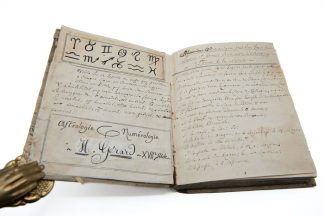GERARD of Cremona.
ASTRONOMICAL COMPENDIUM
[Geomancie astronomique].
France, Manuscript, on paper, 1699.£2,950.00
4to. pp. [1], 265, [1], first and last leaf pasted onto later eps. In French, approx. 16 lines per full page, black-brown ink, elegant secretary hand. 7 half-page hand-drawn horoscopes (some dated 1699) and a few more diagrams and tables, couple of pasted paper slips. One leaf torn away not affecting text, the last few ll. or so waterstained at lower outer corner with paper softening and some loss, occasionally affecting text. In quarter calf, boards covered with C16 vellum legal document, ties, spine c.1800 gilt, paper label, couple of cracks. Modern bookplate to front pastedown, C20 ms ‘Astrologie & Numérologie H. Gérard XVIIe siècle’ (Fanch Guillemin’s hand?) at foot of p.1, inscription stating that the ms was found in an abandoned castle at Plouvorn (Guillemin’s hand?), C19 purple stamp ‘Le Sorcier Blanc Fanch Hocus Pocus’ and in pencil ‘Guillemin’, two clover leaves dried and pasted to rear ep.. In folding cloth box.
Very curious French ms on astrology and numerology – a late C17 astrologer’s compendium of several works, medieval and modern. The ms ‘1699’ within a few horoscopes may suggests a date for composition. The first half is a selection from the influential ‘Geomancie astronomique’ by the Italian astrologer and physician Gherardo da Sabbioneta’s (fl. early C13). He was often mistaken for the great translator from the Arabic, Gerard of Cremona (fl. C12); in 1662, when it was first published in French, ‘Geomancie’ was attributed to the latter. Geomancy is the art of divination through the interpretation of random patterns or markings obtained by tossing soil or other materials randomly; numerology, or arithmancy, assigns numerical values to words or letters for divination purposes. This ‘fine work’ shows how the Geomantic characters – the 16 figures of geomancy, each representing a different state of the world – can be treated astrologically’ (Gardner, ‘Bib. Astr.’, 502). There are minor variations here from the first printed edition (1662), in phrasing and content; the section excluded, e.g., referring to kings, bishops, etc., were probably irrelevant to the writer. The detailed workings and aspects of the 12 Houses and the 7 Planets are first explained, then applied to everyday problems such as how to tell whether a woman is pregnant, an illness will turn for the better or worse, a war will last long, or whether a traveller will make a safe return. Halfway through the source of the ms changes to Peruchio’s ‘La chiromance, la physionomie et la geomance’ (1657). Thence the scribe copied a charming engraving showing correspondences between astrological and geomantic symbols, and their effects, as well as, with slight variations, a diagram applying the geomantic figures to the days of the weeks and the planets. There follows a section on ‘judgements by figures’, matching the 16 geomantic symbols with interpretations, e.g., ‘la figure du chemin’ denotes travel, the prison figure denotes external ailments, etc. A large table summarises the text with judgements applied to family members, health, voyages, etc. The final part returns to Gerard’s ‘Geomancie’, with rules for divination using the alphabet with various strings of numbers, for specific questions, e.g., which of two men shall win a contest.
The early owner was doubtless an astrologer. Whilst we have not traced the abandoned castle where this ms was allegedly found, Plouvorn suggests a Breton provenance. Considering that both Gerard’s and Peruchio’s are now scarce, they probably had a low print-run and were hard to get hold of outside Paris. This copy was also in the library of the C20 Breton illusionist and historian of magic Fanch Guillemin.
In stock







